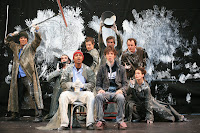
Its far from a fairytale and yet this story bears a few resemblances to “The Emperor’s New Clothes”. That most prestigious of French cultural institutions, the Comédie-Française, has invited the avant-garde of Flemish/Dutch theater, in the persons of Damiaan De Schrijver, Peter Van den Eede and Matthias de Koning, to teach their craft to its noble players, or, to work the metaphor, to dress up a centuries old majesty in the latest and coolest threads. The result is “Paroles/pas de roles… vaudeville”, a piece conceived around the notion of repertoire and the preservation of theatrical history (the primary mission of the Théâtre-Français), on the one hand, and the anti-theatrical preoccupations of the project’s guest artists, on the other.
It should be said that the companies from which this trio hail, tg STAN (Antwerp), De Koe (Antwerp) and Discordia (Amsterdam), have come to occupy the vanguard of contemporary European theater in Paris, sharing a similar interest in laying bare all theatrical conceit to explore the motivations and role of the actor in the dramatic moment, while displaying formidable acting skills themselves, finely tuned textual readings and a post-modern look at it all. While STAN is the best known in Paris, enjoying regular invitations from the Festival d’Automne and long-standing support from the Théâtre de la Bastille, members of all three, which operate as collectives, collaborate freely with each other. One such project, by the same De Schrijver/Van den Eede/de Koning threesome, was a condensation of the companies’ commonly held preoccupations and a revelation of the 2003 Festival d’Automne: “Du serment de l’écrivain du roi et de Diderot” (“vandeneedevandeschrijvervandekoninganddiderot”, in Dutch), based on Denis Diderot’s essay, “The Paradox of Acting,” took to heart the French philosopher’s much debated thesis that to move the audience to engage emotionally with the action of the play, the actor must himself remain emotionally neutral.
Suffice it to say that Diderot’s ideas on the subject of acting have not been much implemented at the Comédie-Française. The decision by the theater’s current administrator, Muriel Mayette, to expose its
sociétaires and
pensionnaires (the two grades of troupe members) to the zero-actor approach of their colleagues in the Low Countries falls under the Théâtre-Français’ more recently assumed objective to venture beyond the classic repertoire produced at its Salle Richelieu venue, by interacting with modern texts and contemporary European directors. Increasingly imitated in France (the company known as “Les Possédés” are obvious admirers), as yet never duplicated, the particular theater equation arrived at by STAN, De Koe and Discordia nevertheless remains, after two months of exchanges and rehearsals, a conundrum for the cast of "Paroles..."
The problem was clearly foreseen, however, by the three directors. As they wrote presciently in the production notes, “With so little time to prepare the actors, the risk is that they will latch onto an appearance of what they want to express, that they show us the form while failing to anchor the project’s subject in their own experience.” (“En si peu de temps de preparation pour les comédiens, le piège serait de s’accrocher à l’extériorité de ce qu’il veulent exprimer, qu’ils montrent la forme sans que le propos vienne de l’intérieur.”). This is precisely the point at which the quintet of actors arrived, but could not surpass, on the opening night.
On a bare space strewn with backstage debris (props, ladders, coats…) and tied up in literal knots by wires and ropes operating curtains and sets, the three actresses and two actors play an ever-repeating, familiar scenario of characters assembling for an anticipated event, and parting when it is over. While the situation they attempt to enact is made deliberately difficult by stage lights that abruptly extinguish, props that are maddeningly missing and direction to talk over each other (so to better destabilize the normative
jeu d’acteur in which they were trained), the obviously energized and invested troupe never seemed to find sufficient motivation in the exercise. It may be unfair to hold their efforts up to a standard achieved from decades of reflection, experimentation and improvisation, but a recent STAN performance such as “Le chemin solitaire” (in December), demonstrated to what extent understanding and meaning issue organically in performances by the Dutch and Flemish companies, despite and indeed because of such obstacles to role playing. The temptation to act generally got the better of good intentions in "Paroles...", although Laurent Natrella and Léonie Simaga just as often achieved a necessary humility and distance from character.
As the Emperor found to his dismay, the gorgeous attire he thought he was putting on only exposed his true nature. This latest initiative by the Comédie-Française will be truly splendid if it can shake some of the dust off an art in need of renewal and inject new practices into a venerable institution, to help it do better the repertoire it does best.
To February 28, Tues, 7 pm, Wed-Sat, 8 pm, Sun, 4 pm, Théâtre du Vieux-Colombier, 21 rue du Vieux-Colombier, 6e, M° St. Sulpice, 8 euros-28 euros, tel: 01.44.39.87.00.
Photo credit: Christophe Raynaud de Lage























